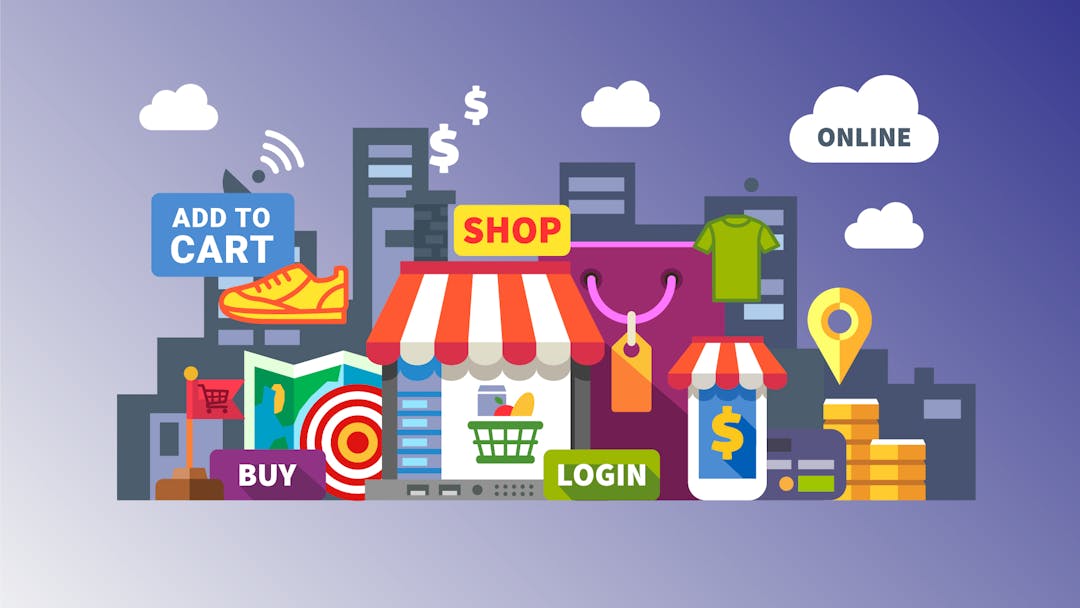With COVID-19 forcing physical stores to close, the need for online retail has never been more clear. On top of the pandemic, the efficiency of the direct-to-consumer model is helping to further drive retail's shift to the internet. Technology has certainly opened up the opportunity to cut out the middleman in ways that weren't possible just a few decades ago. What does the switch to a DTC business model entail, and is it the right choice for your business? We'll answer those questions and more in this post
What is the direct to consumer business model?
Direct to consumer, D2C, or DTC stands for a retail business model which eliminates any intermediaries. In other words, brands that implement the DTC business model sell their products directly to customers, thus obtaining control over the entire sales process. DTC provides brands with the opportunity to establish direct relationships with their target market built on trust.
Traditionally, you would sell your products to a retailer, who would then sell them to customers. This was beneficial when customers had to go to physical stores to buy products. Mail-order catalogs could sell direct, but that required more infrastructure than most businesses had available to them, so most mail-order catalogs were still operated by large retailers. Now that the latest direct-to-consumer statistics show customers are willing to buy directly from a company website, the reliance on physical stores is weakening, making it practical to skip the middleman and sell directly to customers.
How is the direct to consumer model different from traditional retail?
With the definition out of the way, let's talk about why companies find the switch to D2C worthwhile. There's the obvious benefit of cutting out the middleman, but there are a number of other advantages that come from the DTC model as well.
Shortened supply chain
With no retailer between you and your customers, the supply chain is at least one link shorter. This allows companies to have more control over the entire customer journey, from customer acquisition to building lasting relationships with loyal customers.
Reduced time-to-market
The shortened supply chain, combined with the freedom to act independently of the whims of retailers, allows you to bring your products to market even faster. Thanks to the direct to consumer model, companies are also able to develop direct feedback loops with customers and get a better pulse on market trends.
Stronger long-term customer relationships
Anytime people deal directly with one another, their relationship is strengthened as a result. This is no different with you and your customers. Cutting out the middleman by turning to the D2C model will allow you to forge closer ties with your customers and increase their lifelong value.
Greater control over branding
Retailers often have branding guidelines in place that the DTC business model will free you from. They also often advertise products sold in their stores on their own. With DTC, your company is in full control of your marketing strategy and can develop creative ways to acquire new customers.
Digital-centric
Because DTC brands rely heavily on the internet traffic to make their sales, they often leverage digital marketing strategies such as influencer marketing through social media. Digital advertising is highly targeted towards the end customer, provides a great ROI, and increases profitability.
Subscription-based pricing
One of the fastest growing pricing models is subscription-based pricing. Direct to consumer brands are typically subscription-based because it creates a consistent revenue stream for your business and is retention focused, which is extremely important for the success of a DTC company.
History of the direct to consumer business model
The rise of the direct to consumer model is relatively recent, at least as a primary means for companies to do business. In this section, we'll take a look at how, and why, DTC sales got their start as a major force in business.
Personal computing: the first retail space to go DTC
Giant personal computer manufacturers such as IBM and Apple realized their computers came in a dizzying array of configurations that most retailers weren't keeping in stock. As soon as technology allowed, switching to DTC sales allowed them to offer new products to end consumers with much less friction than would have been required before. Apple took this a step further by creating their own retail stores where they could sell direct to consumers but still benefit from a physical retail space in heavily traveled shopping areas.
Rise of the first successful DTC startups
With the viability of the DTC model firmly established, it wasn't long before startups were founded specifically as DTC businesses. Companies like Warby Parker began selling eyeglasses directly to consumers. Mattress company Casper, Everlane Clothing, and beauty product supplier The Honest Company all joined in to make up the first generation of digitally native companies that were DTC from the start businesses.
More startups jump into the DTC space to monetize great customer experience
The success of these startups showed entrepreneurs two things: first, that DTC could be a successful model, and second, that you didn't need expert-level knowledge of the product you were selling in order to become a success in the DTC market. This led to companies like Dollar Shave Club joining the DTC space in an effort to bring more products that were considered overpriced into the affordable range that the DTC model allowed for. A few years after their founding as a spunky startup, Dollar Shave Club was purchased by mega-brand Unilever for $1 billion.
Big brand retailers test the DTC waters
With large brands such as Apple and IBM kicking off the trend and Unilever spending $1 billion on a DTC company of their own, other once retail-only manufacturers have begun to take notice. Nike famously switched focus to more of a DTC model recently, joining Apple in creating their own physical DTC stores that now compete directly with the footwear distributors they once relied on.
DTC brands transition back to traditional ecommerce retailers
Huge ecommerce retailers like Amazon and Walmart now make it easy for anyone to place products on their virtual shelves. In many cases, the manufacturer themselves can even handle the shipping. This arrangement brings back the middleman, but has proven an attractive option for many DTC brands. They keep a large amount of control and give up less percentage of the profit than they would to a traditional retailer, but still get the benefit of having their products on an ecommerce platform that has a larger customer base than they could reach otherwise.
Why is the market turning towards the direct to consumer model?
Although each company who makes the decision likely has many individual reasons, there are at least three major factors that play into the switch to DTC business models by startups and major brands alike.
Margins from multichannel retail are shrinking
Large online retailers like Amazon, which we've seen are still used by mostly DTC companies, have taken large amounts of business away from brick-and-mortar stores. This results in those stores being more picky about the products they sell and reduced margins on those products that they do decide to carry.
Changes in consumer expectations
There was a time, in the early days of the internet, that going to a manufacturer's website and having to click on a 'where to purchase' button to find links to third-party retailers was acceptable. Today, consumers expect to be able to make a purchase from the same site that they're reading about a product on. This has caused a boom in ecommerce entrepreneurs who combine consumer packaged goods with technology to build profitable digitally native brands.
Advancements in technology
You can now source products, take orders, and handle fulfillment all from the comfort of your home computer. This makes it easier than ever for enterprising people to create their own DTC stores, and lowers the barrier to entry for startups and existing businesses alike to launch and promote new product lines.
4 examples of successful D2C brands
There are far more DTC brands than we could cover in one blog post, as the business model is currently exploding in popularity, but we wanted to cover some major players that we haven't already discussed, and talk a little about how they are leveraging DTC.
The Sill
Getting the perfect houseplant to compliment your decor used to mean going through the hassle of heading down to the local home and garden shop and hoping they had something you liked in stock. The Sill changed that when they brought a complete selection of potted plants to the ecommerce world. Like some other DTC brands, The Sill also has physical locations in select cities.
Billie
Razor company Billie did for women what Dollar Shave Club did for men. They have since grown to include a wide range of beauty products that give women higher quality for lower prices, just as DTC was meant to do.
Death Wish Coffee
Gourmet coffee grounds are big business, but you won't often find them in your local grocery store. Death Wish Coffee solved this distribution problem by taking their unique brand of extra strong coffee directly to consumers.
Ritual
Unhappy with the state of the multivitamin industry, Ritual set out to create a vitamin with transparently-sourced, high-quality ingredients. They now have a range of products that cover multiple nutritional needs and sell directly to consumers through their website.
ProfitWell Metrics: the subscription growth secret weapon of DTC brands growth
As we mentioned, most DTC brands leverage a subscription model to sustain their business over time. Subscription-based pricing can be one of the most profitable ways to manage pricing, but you need to understand how the direct to consumer model works.
Get an overview of your DTC analytics with ProfitWell Metrics
We realized this very early on (being a subscription company ourselves) and created our free ProfitWell Metrics subscription analytics tool. With it, you'll be able to track all the important subscription KPIs that you need to understand in order to maximize your subscription revenue. and adapt your strategy.
Beat DTC churn with Paddle Retain
As we’ve said time and again, pricing is the driver of subscription businesses. Use Price Intelligently to leverage machine learning for optimal pricing.
Conclusion
In just a few years, DTC has gone from a model with one of the highest barriers to entry and morphed into a profitable business model that is easy for everyone to adopt. Small startups and big brands alike are discovering the power and flexibility that going direct to their customers affords them. As technology makes doing business online even easier, we expect to see continued DTC growth.
Direct to consumer (DTC) FAQs
How do you go D2C?
To take your business D2C, you need to get the buy-in of all stakeholders. Your business should also take into account the infrastructure required to bring your brand D2C. This includes: marketing, sales, managing order fulfillment and shipping, and customer relationships. Ensuring that your business is able to take on the full scope is key to a successful D2C business.
What is the difference between B2C and D2C?
B2C stands for “Business to Consumer” where goods and services are sold by businesses to the end customer and can involve retailers as the middleman distributor. D2C stands for “Direct to Consumer” where orders are purchased on an ecommerce website and fulfilled directly by the business to the consumer, sometimes using a 3PL.
Can established non-digitally native brands pivot into a D2C model?
Yes, this has been proven by brands like Apple and Nike, which launched their own flagship outlets. The benefit of moving from traditional retail to a D2C model is gaining more control over your entire supply chain, and establishing direct relationships with your customers.
What are the benefits of D2C businesses?
The D2C business model offers businesses more control over their supply chain, the way their brand interfaces with customers, and revenue potential through offering subscriptions.

